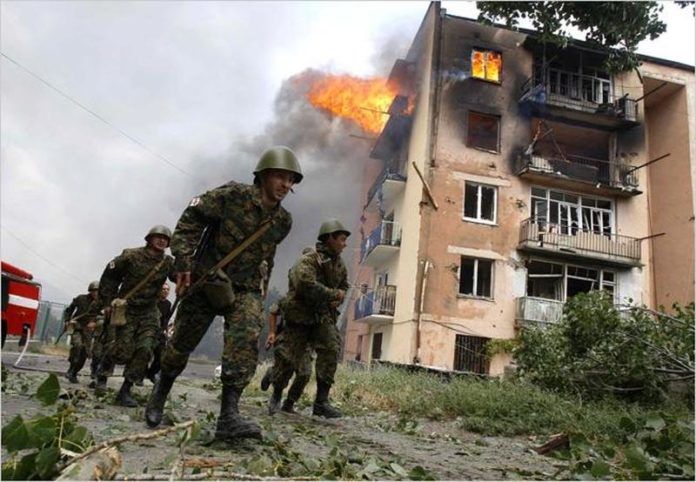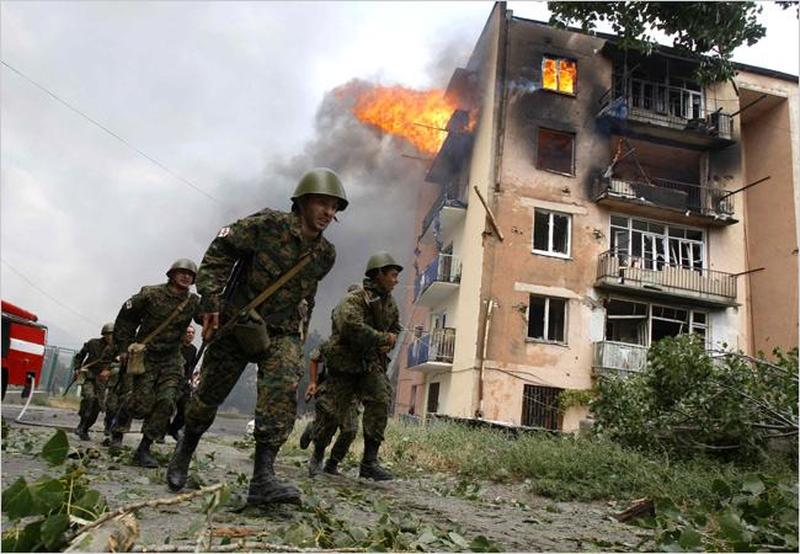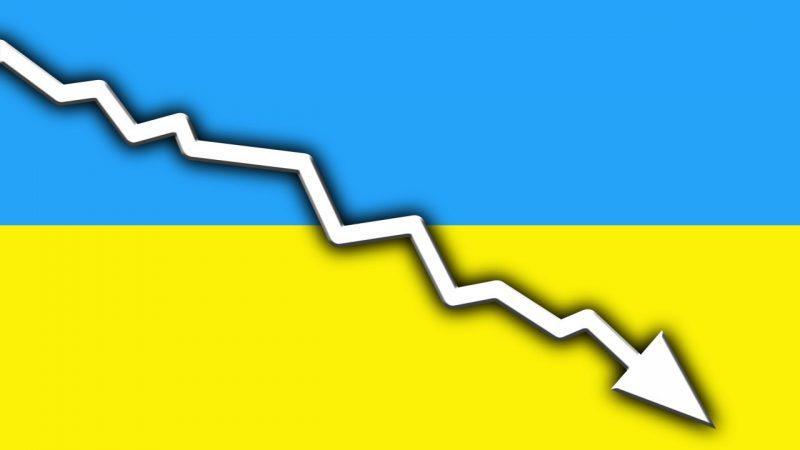
THE NATO BUILD-UP
2014: The expansion of NATO in the late 20th and early 21st centuries had posed a serious strategic threat to Russia’s security. In 1999 the Czech Republic, Hungary and Poland joined NATO. In 2004 they were followed by the Baltics, Romania, Bulgaria, Slovakia and Slovenia; Albania and Croatia joined in 2009.
This influx was in addition to most of the western European states which had been members of NATO since the ‘Iron Curtain’ came down soon after hostilities had ceased in Europe in 1945. In all, 28 countries are now members of the alliance. Non-NATO members including, Sweden, Finland, were brought into line with EU/NATO policy after their accession to the Lisbon Treaty. Thus economically, politically and militarily the West had arrived at Russia’s western borders.
Viewed retrospectively, however, this was the high point of NATO hegemony. The juggernaut seemed to be at the height of its power, but the turning points had already come with the brief Russo-Georgia war in 2008 and then Ukraine 2014/15 when Russia said nyet.
COLOUR REVOLUTIONS
Colour revolutions financed by US Non-Governmental Organizations (NGOs) in the shape of the National Endowment for Democracy (NED), US-AID, and Human Rights Watch (HRW) were complementary to the EU/NATO expansion eastwards and had targeted both Georgia and Ukraine. Additionally, Soros’s Open Society and its many tentacles also took part in these operations.
The NED could not be called an NGO since it was funded directly by the US government which made it a “GO”. This was openly admitted later by Victoria Nuland – Under Secretary of State for Eurasian and East European Affairs, and Wife of leading neo-con warmonger Robert Kagan – during a talk which she gave at the Washington press club. (See the you tube). Ms Nuland also took the opportunity to inform the audience that the going rate for colour revolutions was US$5 billion.
TARGETING GEORGIA AND UKRAINE
The first political drive into Ukraine began with the Orange Revolution of 2004 with Yuliya Tymoshenko and Victor Yuschenko taking power. But this didn’t last long as both were congenitally corrupt and soon fell out with each other over the share of the spoils.
Victor Yanukovich whose base was in the Eastern oblasts of Donetsk and Lugansk and head of the Party of the Regions, was elected President of Ukraine in 2010. Yanukovich, never particularly popular in the west and central Ukraine, was ousted in the coup of 2014 supported by NATO/EU, the above-mentioned NGOs, and a motley collection of oligarchs, centre-right politicians and outright neo-fascists from Lviv, and Ternopol the far west of the country (Galicia).
Now the political drive was augmented by a military drive involving armed conflict in a war in the East of the country which is still ongoing. The new ‘President’ Poroshenko (ex-Finance Minister in Yanukovich’s 2010 government) launched what he called an ‘anti-terrorist’ operation which was to last a few hours at most.
Five years later the conflict is still simmering in the Donetsk and Lugansk regions in the Russian-speaking east of the country. Ultra-nationalist irregular militias from the western provinces and the Ukie regular army were meant to push right up to the Ukraine/Russian frontier and possibly deploy ABM systems.
Well, that was the plan. But we should all know by now about military plans. As the Prussian soldier and military strategist Helmuth von Moltke the Elder succinctly put it: “No battle plan ever survives first contact with the enemy.” Obviously the Ukies were not au fait with Herr Moltke and his works.
Additionally, the Russian naval base in Sevastopol/Crimea was being eyed by the US Sixth Fleet for future operations in the Black Sea. The Russians had been in occupation of this base for centuries and had some 16 thousand Russian servicemen permanently stationed there, with the additional proviso in the lease that another 10 thousand could be mobilised if necessary.
Russia paid Ukraine some $500 million annual rent for the use of the base and held the lease until 2042.
NATO’S PROXIES HIT A BRICK WALL
As it turned out the EU/NATO plan was stopped in its tracks mainly due to the fact that both in the Don Bass as well as in the Crimea the population was ethnically Russian.
The Crimean population did not recognise the putschists in Kiev as their government since the illegal regime had come to power by violent means and had also banned sizeable opposition political parties – e.g., the Party of the Regions and Ukrainian Communist party, the predominantly Eastern Ukrainian political entities.
Crimean people therefore transferred their loyalties to Russia eventually seceding from Ukraine to become part of the Russian Federation. In the Donetsk and Lugansk oblasts the Ukrainian military met with stiff resistance and were halted by the heavy defeats firstly at Ilovaisk in 2014, and then Debaltsevo 2015.
Hastily formed local para-military forces, aided by Russian artillery, arms and high-tech Electronic Warfare played a crucial role in these operations. Since that time, and apart from the occasional shelling from the Ukrainian side, the war has settled into a frozen conflict.
(A note in passing: the continued Ukrainian shelling of Don Bass civilians which is of course contrary to UN law, receives no attention whatsoever in the western media (why am I not surprised?) neither do the obscene rallies of up to 20,000 ultra-nationalists which take place in Kiev every January celebrating the birthday of the war criminal Stepan Bandera and the Ukrainian Insurgent Army UPA. Banners, Torchlight processions, pictures of Bandera, pure Leni Riefenstahl Nazi rally pastiche.)
BROKEN DREAMS
2019: After all the promises, EU flags, and hoopla in Independence Square (Kiev) the Ukrainian economy is now a shambles and Ukraine is the poorest country in Europe apart from Moldova.
The ‘Government’ (exited by Poroshenko and succeeded by the ex-comedian Zelenski who received a very large majority vote, due to the fact that the mass of the population want peace) is only kept in power by the oligarchs, principally Kolomoisky, and the armed ultra-nationalist militias, as well as handouts from the IMF.
There was a very famous line from the East European Marxist, Karl Radek:
‘Fascism is the iron hoop around the broken barrel of capitalism.’
Much the same can be said about Ukraine.
WESTERN EUROPEAN TRAVAILS – GEOPOLITICAL AND ECONOMIC
Coincidental with these events the economic situation in Europe has entered into a turbulent period. I hesitate to use the word ‘crisis’ but consider the core of the system, Germany, which if not actually in recession then is very near.
Growth Year on Year (YoY) from July 2018, July 2019 is 0.4% – what you would expect in the middle of a depression. UK’s growth figures are slightly better coming in at 1.2% YoY. Poor old Italy recorded a GDP growth of -0.1% YoY, (that’s a minus sign by the way).
Rubbing in the salt Italy has a Debt-to-GDP ratio of 132% and finally France YoY growth rate of 1.4% and a debt-to-GDP of 97%. That’s the big four in the EU/Eurozone.
So, the biggest economies in EU/Eurozone have a growth rate ranging from -0.1% to 1.4%. Oh, and I almost forgot negative interest rates are now becoming the norm in euroland and 85% of German Bunds are non-performing and/or interest rate negative.
Not very encouraging, and now the ECB is getting geared up for another round of QE, which means that the euro is going to be devalued. Of course, the Americans aren’t going to be best pleased with this turn of events.
With the exception of the Atlanticist knuckleheads – the UK, Poland and the Baltics – there is now a discernible rift taking place between the US and its Vassal states in Europe. For starters Germany in its present economic travails is not going to welcome any increased costs for its export industries.
Most importantly this includes raw material costs which underpins Germany’s manufacturing/export sector. Natural Gas and oil are piped to Germany from Russia and the construction of Nordstream 2 is crucial to the German economy but is infuriating the Americans who want to force, repeat force, Germany to buy more expensive, less reliable, Liquified Natural Gas (LNG) and are threatening to sanction any company and/or state to get their own way.
GERMANY’S ENTSCHEIDUNGSZEIT (DECISION TIME)
This is a clearly a re-run of history and a moment of truth for the Germans. Do they do what the Americans tell them, which would be akin to committing economic suicide, or will they pursue their national interests as they really ought to be doing . This was precisely the setting in 1985 though this time with Japan the object of US financial and economic destabilisation.
The Plaza Accord, as it was called, was a joint-agreement, signed on 22 September 1985, at the Plaza Hotel in New York City, between France, West Germany, Japan, the United States, and the United Kingdom, to depreciate the U.S. dollar in relation to the Japanese yen and German Mark.
The signing of the Plaza Accord was significant in that it reflected Japan’s emergence as a player in managing the international monetary system. However, the bad news was the resulting recessionary impact which pushed up the value of the Yen against the dollar in Japan’s export-dependent economy.
Worse still this created an incentive for the expansionary monetary policies that led to the Japanese asset price bubble of the late 1980s. The Plaza Accord contributed to the Japanese asset price bubble, which progressed into a protracted period of deflation and low growth in Japan known as the first Lost Decade. Has Germany, and by implication Europe learned the lesson one wonders?
Bearing this in mind it should also be noted that Germany is a big investor in Russia.
Russia remains one of the top investment destinations for German businesses, despite tensions between Washington and countries facing steep sanctions, including the European Union.
Within the first quarter of 2019, foreign direct investment by German businesses in Russia has seen a 33 percent increase compared to the same period a year earlier, totalling €1.76 billion ($1.98 billion), according to a statement released by the Russian-German Chamber of Commerce.
“Despite weak market conditions, German companies continue to believe in the Russian market,” said Matthias Schepp, the chamber’s chairman, on Thursday, highlighting the upward trend of German business in Russia.
Although the Russian economy was at a standstill from 2014-2017 mainly due to sanctions that had been imposed over the Ukrainian crisis in 2014, Germany has remained a stable business partner. Europe’s largest economy has 10 times more companies registered in Russia than the other European Union states, accounting for nearly 4,500 companies.
German big business, therefore, likely does not want to see its exports blocked in order to appease US geopolitical ambitions. And there is little sympathy among most of the German public for the ongoing US/NATO occupation. The decline of the SPD and CDU and rise of the AfD are indicative of this trend.
In a recent study it was found that the traditional relationship between Germany and the US was beginning to fray.
Americans and Germans have vastly different opinions of their bilateral relationship, but they tend to agree on issues such as cooperation with other European allies and support for NATO, according to the results of parallel surveys conducted in the United States by Pew Research Centre and in Germany by Körber-Stiftung in the fall of 2018.
In the U.S., seven-in-ten say that relations with Germany are good, a sentiment that has not changed much in the past year. Germans, on the other hand, are much more negative: 73% say that relations with the U.S. are bad, a 17-percentage-point increase since 2017.
Nearly three-quarters of Germans are also convinced that a foreign policy path independent from the U.S. is preferable to the two countries remaining as close as they have been in the past. But about two-thirds in the U.S. want to stay close to Germany and America’s European allies.
Similarly, while 41% of Germans say they want more cooperation with the U.S., fully seven-in-ten Americans want more cooperation with Germany. And Germans are about twice as likely as Americans to want more cooperation with Russia. All this is happening against a backdrop of previously released research showing a sharply negative turn in America’s image among Germans.
Interestingly enough the most pro-NATO, pro-American outfit has been Daniel Cohn-Bendit’s Green Party – Die Grunnen. It seems that the 1968 version of Danny the Red, has transmuted into the 21st century Danny the Rat.
EMMANUEL MACRON QUA CHARLES DE GAULLE
Now joining the chorus of a possible EU independence from US is none other than Emmanuel Macron. In what seemed completely out of character perhaps, were Macron’s perorations which were eerily reminiscent of Charles De Gaulle both in their timing and sentiments. There was a clear message that the old Atlanticist geopolitical and economic global order has had its day. Lèse-majesté Indeed.
[See The Saker for a full account – The Unz Review, 12 September 2019]
PANIC OF THE GLOBALISTS
Earlier a similar break from current orthodoxy came surprisingly from the Chairman of the Bank of England, ex-Goldman Sachs former employee, Mark Carney, which took place at Jackson Hole Symposium 2019 23 August 2019. Herewith a brief resume from the Financial Times:
Mark Carney, the Bank of England governor, has said that the world’s reliance on the US dollar “won’t hold” and needs to be replaced by a new international monetary and financial system based on many more global currencies. In a speech at the annual Jackson Hole gathering of central bankers in the US, he called for the IMF to take charge of a new system of currencies, ensuring emerging economies from destructive capital outflows in dollars and removing their need to hoard US currency. In the longer term the IMF could “change the game” by building a multipolar system, he said.”
– Financial Times, 23/8/19 (paywall)
So, there we have it. Neo-liberalism and Globalization (which is neoliberalism writ large) no longer works. The holy trinity of free movement of labour, capital and commodities is no longer fit for purpose. Similarly, with the dollar, which isa key part of the present defunct global monetary and financial system. A new global currency needs to be constructed, which is precisely what Keynes argued in 1944. In fact, this is not news when restricted to opponents of globalization and neoliberalism, but it is news when being articulated by leading establishment figures such as Carney.
With all due respect to Antonio Gramsci I think the new is being born. The accelerating pace of events is leaving the know-nothing talking heads and their ilk in its wake. The view from the United States? Conspicuous by its absence.
They simply seem unable to fathom what is going on in the world. Thus, a geopolitical and economic fissure of San Andreas dimensions seems to have become a fait accompli between the US and the Eurasian bloc; this process, albeit in its earlier stages, now also seems to be developing between Europe and the US.
The post war paradigm seems to be coming under relentless pressures, both internal and external. The fact that Carney, as spokesman, feels it appropriate to point out this fact as the representative of such an Atlanticist basket-case as the UK makes these views even more significant.
The move from a unipolar to a multipolar world just got another big (and perhaps definitive) push.
Next up: 2020?






